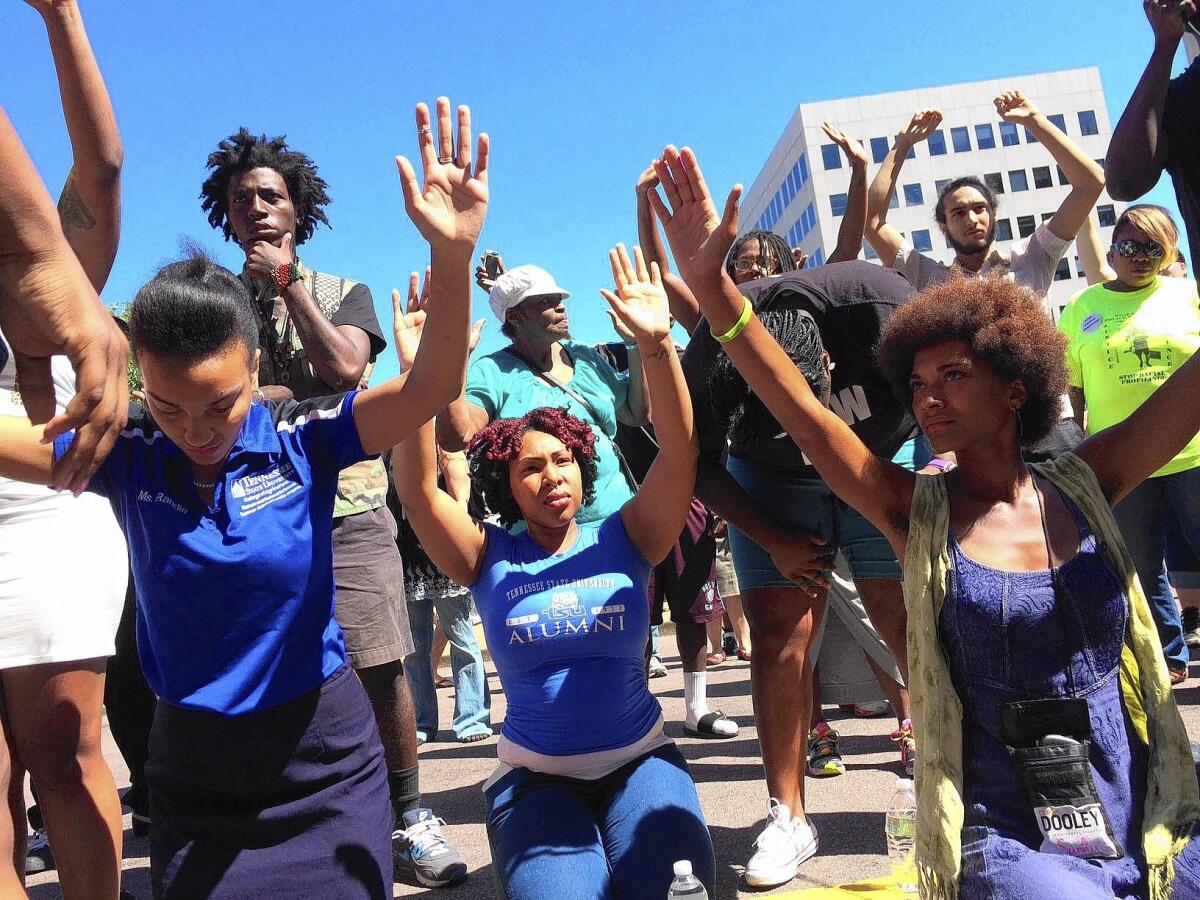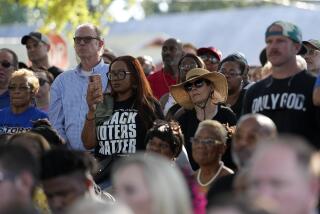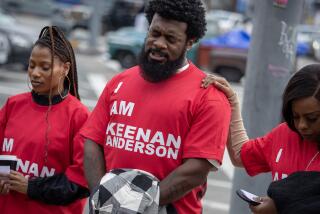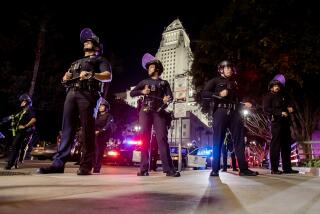Protesters use hands-up gesture defiantly after Michael Brown shooting

reporting from CLAYTON, Mo. — Yet again, the protesters took to the sidewalks and streets, facing a row of police guarding the St. Louis County prosecutor’s office. “Hands up!” they chanted, their arms aloft. “Don’t shoot.”
“This is how the boy died!” Kendrick Strong, 42, hollered at police officers Tuesday morning. “This is how the boy died! With his hands up in the air!”
As St. Louis’ predominantly black northern quarter has teetered toward chaos the last four days after police in the suburb of Ferguson killed an unarmed black 18-year-old, the chant has been one inescapable constant amid the worry and confusion and clamor.
The hands-up — a sign of surrender and submission black men and boys here say they learn early on when dealing with police — has been transformed into a different kind of weapon.
“If you’re angry, throw your arms up,” said the Rev. Al Sharpton, who traveled to St. Louis in the wake of the death of Michael Brown. “If you want justice, throw your arms up. Because that’s the sign Michael was using. He had a surrender sign. That’s the sign you have to deal with. Use the sign he last showed. We want answers why that last sign was not respected.”
Brown was shot and killed by an officer Saturday while Brown, according to witnesses, was running away with his hands up. Police say the shooting occurred after a struggle between Brown and a policeman over the officer’s gun.
In the days since the shooting, riot police have been sweeping the streets in scenes that might be more recognizable in the Middle East. Stores have been looted, a gas station burned, a Catholic charity’s window smashed. Teens have hurled rocks at cops. Officers have launched tear gas.
Benjamin Crump, a lawyer representing Brown’s parents, has demanded that police identify the officer who shot Brown, but the Ferguson police chief declined to do so, citing death threats.
President Obama, noting the Justice Department is aiding local officials in investigating the shooting, said in a statement Tuesday, “I know the events of the past few days have prompted strong passions, but as details unfold, I urge everyone in Ferguson, Missouri, and across the country, to remember this young man through reflection and understanding.”
Local and national black community organizations have begun deliberating their roles in how to respond to Brown’s death. And everyone wonders when the convulsive nighttime violence that has turned Ferguson into an unpredictable “war zone” — as some officers have put it — will end.
Just as “Ferguson” has transformed into instantly recognizable shorthand signifying the latest juncture in an unsettled national conversation over race and policing, the “hands up, don’t shoot” chant has joined a long line of activist slogans that crystallize the heart of a community’s moral outrage: Hell no, we won’t go. No justice, no peace.
Demonstrators had taken up the chant Monday when hundreds of demonstrators, many older, marched in the streets in front of the Ferguson Police Department, their arms raised toward the blazing sun. About two-thirds of Ferguson’s 21,000 residents are African American, but police and city officials are predominantly white.
The black teens and twentysomethings who took to the streets in Ferguson on Monday night did the same, lifting their hands to the glaring lights of a police chopper and the line of police vehicles — with officers in front — trying to keep them at bay.
But they also used the hands-up sign as a tool for provocation, drifting toward the police with their arms up, as if daring for a response. They mixed the hands-up chant with a taunting, obscene anti-police chant. The police eventually drove the group away with tear gas.
In Clayton the following morning, the hands-up protest was deployed again to confront police officers, but with more peaceful intentions. For several black men who looked on as a line of demonstrators held up their hands, some while on their knees, the symbol had powerful and even painful personal resonance.
Mark Sutton, 24, of St. Louis recalled an incident when he was 18. He had gone to the Saint Louis Galleria Mall with his little brother to pick out a prom suit, but ID checkers at the entrance wouldn’t let him in.
Sutton said that as he walked away with a cellphone to his ear, a police officer grabbed his hand; surprised, he yanked his arm away and then was thrown to the ground, handcuffed and Tasered.
“That could have been me in ‘08,” Sutton said of Brown’s fate. “I wouldn’t be here to tell this story. I wouldn’t be here to protest.”
Other men at the Clayton rally, young and old, shared similar stories.
“See this dent?” said Aha Sen Piankhy, 38, tapping a finger to a scar on his face. “I got smacked in the head with a flashlight because I didn’t say, ‘Yes, sir.’”
He added, “I was 14 years old.”
Aha Sen said the hands-up chant was “a good tool” because it showed that police apparently violated the covenant not to shoot when hands are up — a gesture resented among black boys and men in the first place.
Brown, he said, “knew to put his hands in the air, and they still killed him.”
But Strong said he detests the new symbol.
“You’re showing yourself as weak. It says, ‘I give up, I surrender to your authority,’” he said. “Whether his hands were up, if they were down, it doesn’t matter.”
But when a police officer smirked at protesters Tuesday morning, Strong decided, the gesture seemed the best way to express displeasure.
Colbi Drake, 22, a student at the University of Missouri, had a different outlook on holding her hands up, citing other cases of young unarmed black men around the country who were killed.
“This is a very peaceful way of representing the people who aren’t able to do this themselves,” she said. “That was always the symbol of surrendering. ‘I have nothing! My hands are up!’ Why would you still shoot? It makes no sense.”
And then Drake went back to watching the demonstrators facing police, with their arms raised to the sky.
More to Read
Sign up for Essential California
The most important California stories and recommendations in your inbox every morning.
You may occasionally receive promotional content from the Los Angeles Times.











